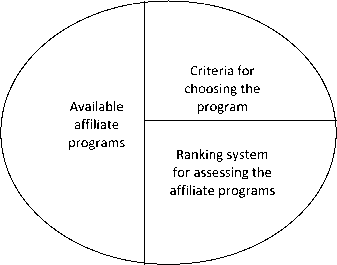Research question 3 Mdq
How do content providers select affiliate marketing programs they intend to participate in?
Affiliate marketing programs are selected by the content provider in two different ways. He either already has a website, where he uses affiliate marketing, or he creates a website to leverage a specific affiliate program. In both cases he goes through a process that is applicable to models that De Boer et al. (2001) and Lee (2001) proposed (models were already discussed in the literature overview).
|
De Boer's model | |
|
Problem definition |
Replacing current affiliate program: Unsatisfactory results Better offer Costs connected to change of provider Selecting new program for new website: Exploit new business opportunities Diversify risk |
|
Criteria definition |
Connected to the chosen topics Adds value to websites Commission rate Expected conversion rate Time length of tracking |
|
Pre-qualification of suppliers |
None |
|
Choice of the supplier |
Linear weighting methods |
The problem definition phase is different, if the content provider already has a website or if he decide to create one in order to exploit benefits of an interesting affiliate program. In the second case, the content provider identifies during the problem definition phase his need to exploit new business opportunities in order to diversify a risk of unsatisfactory results of one website.
In the first situation, the problem definition phase comprises dissatisfaction with the current merchant. It can be caused either by bad performance at the merchant's side or by better offer from a different affiliate program provider. Potential costs connected with the change (such as opportunity cost, time devoted to the change) are also taken into account. If the expected future benefits do not exceed expected costs, the process is finished and content provider will continue using the current affiliate program.
When future benefits are higher than the costs, content provider defines criteria that are important for choosing the affiliate program. In this case, criteria are divided into two groups. First group involves more general criteria - connection to the website topic and ability to bring additional value to the website. Selection criterion determining the necessity of close connection of the program with the topic of the website complies with Papatla and Bhatnagar's theory, that affiliate program is most beneficial, if there is such a connection. Moreover, the other criterion- added value - corresponds with the reasons, why content providers can participate in affiliate marketing enumerated by Duffy (2004).
Second group of criteria deals with the actual income that the program can generate. It includes commission rate, expected conversion rate and length of time, when the customer is tracked after clicking at a banner or a text link.
No pre-qualification of affiliate program providers is done by the content provider, because he does not consider it necessary.
In the final phase, the provider is chosen by linear weighting methods, where the first group of criteria is non-compensatory - there is a minimum level, that has to be achieved and that cannot be offset by anything else.
Criteria from the second group are assigned different weights, which play crucial role in the final decision-making process. The highest weight is assigned to the commission rate and expected conversion rate (which is also connected with possibility to customize freely the ads in the program). Minor weights are assigned to length of time, at which the visitor's activity is tracked after clicking at the banner or link.
The affiliate program with the best results will be selected by the content provider. Linear weighting methods are used because of their simplicity and applicability to various types of situations.
As the content provider continuously searches for new affiliate programs and evaluates them using the above described criteria, Lee's model can be employed as indicated at the figure below. The process of selecting a new affiliate program continues, until a program with significantly better conditions is found.

Figure 19 - Case 1: Criteria for selecting affiliate marketing provider in Lee's model
Figure 19 - Case 1: Criteria for selecting affiliate marketing provider in Lee's model
Was this article helpful?


